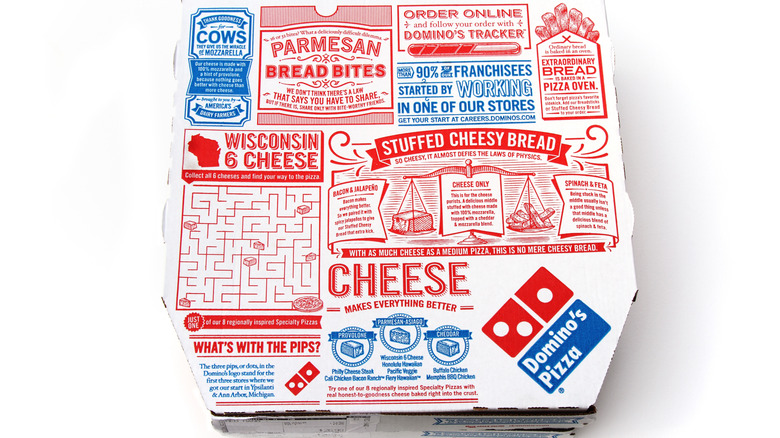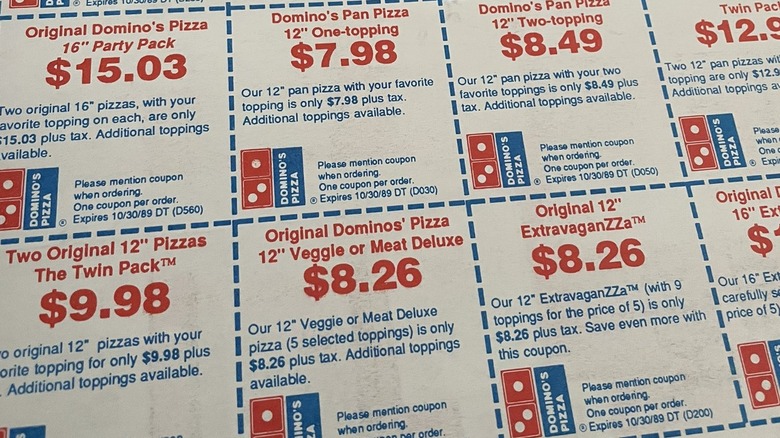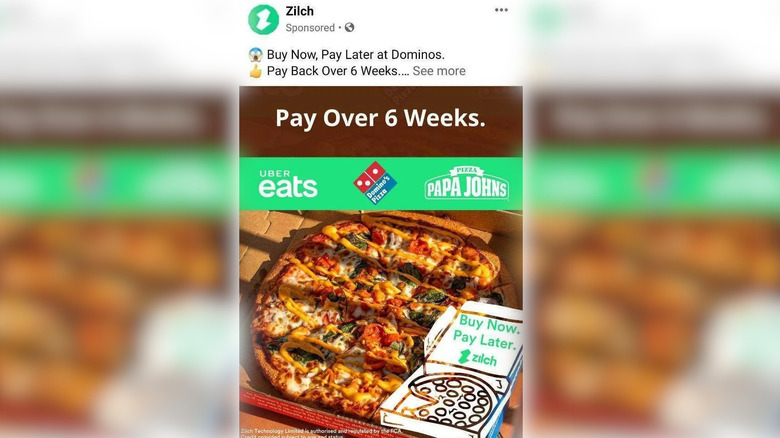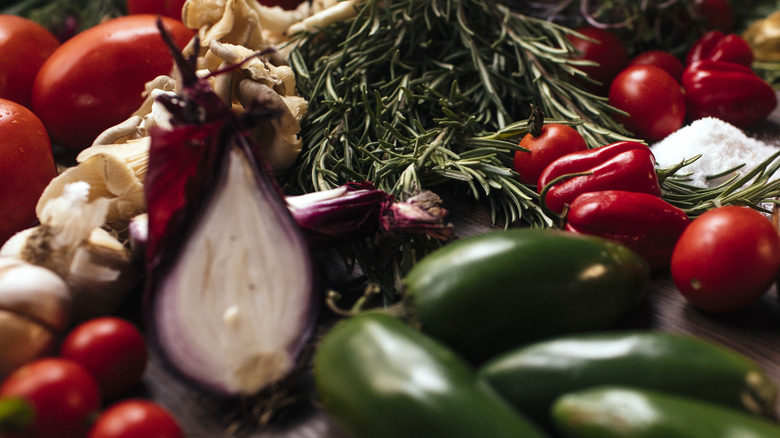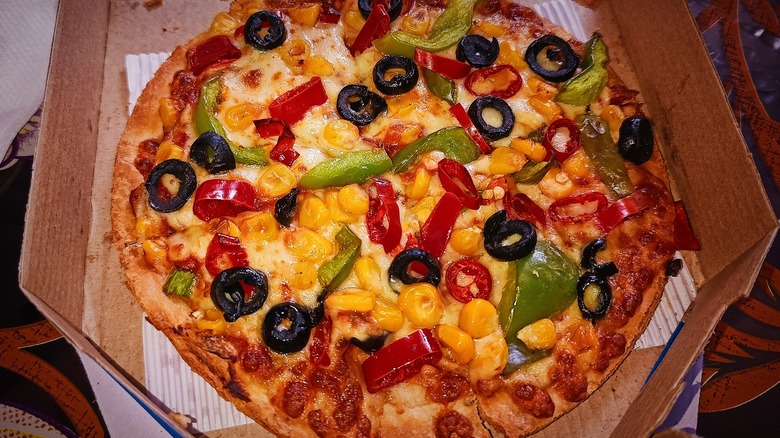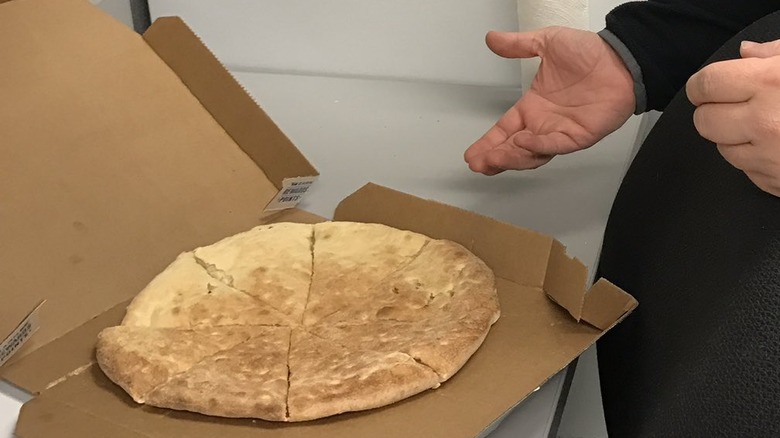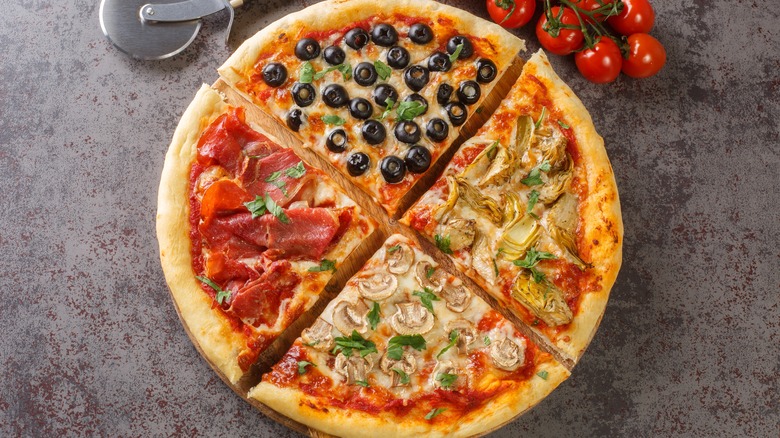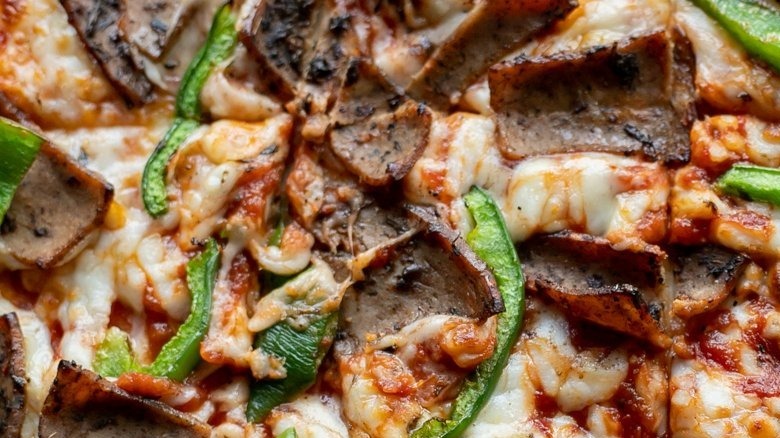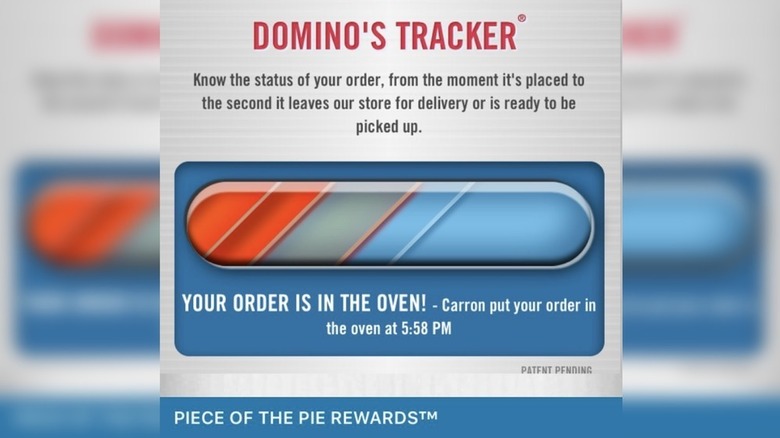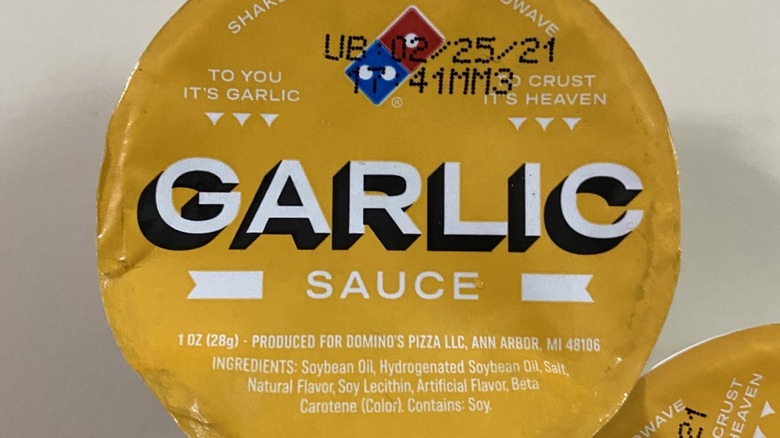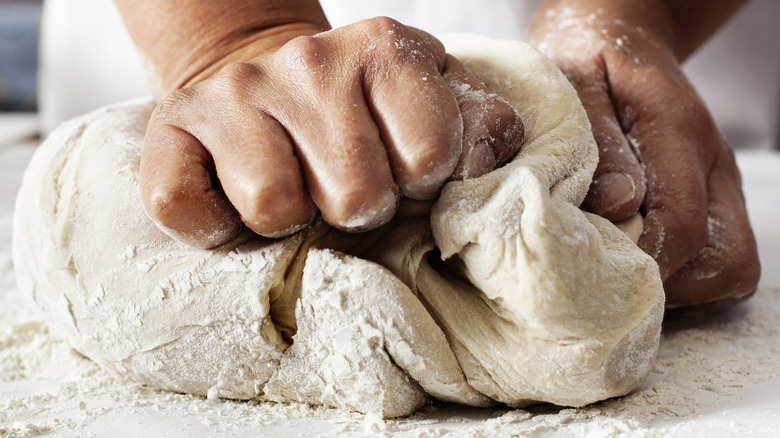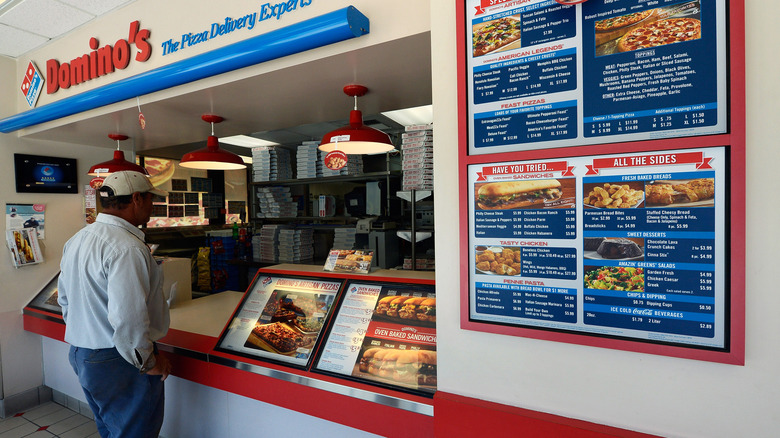Shady Things About Domino's' Menu
Since its inception in 1960, the Michigan-based pizza chain Domino's has undergone several radical transformations to remain competitive in the pizza market. The most notable of these changes was the 2009 "We're Sorry for Sucking" campaign, which entailed both a full menu overhaul and a total rebrand for the company. This campaign was surprisingly successful at repairing the company's reputation among customers, causing the company's market share in the pizza world to rise massively. But now that the dust from Domino's' successful about-face has long settled, it is clear that the company still has some surprisingly shady aspects to its menu. Perhaps another mea culpa is due and big changes could be coming to Domino's again soon.
Don't worry, Domino's enthusiasts. We aren't here to uncover anything outright criminal about this now-beloved multinational pizza chain. Instead, we aim to highlight sketchy and questionable practices ranging from potentially harmful food ingredients to dubious ordering system quirks. Our goal is not to question Domino's' pizza–making expertise, as the company is competent at that. Instead, our goal is to demonstrate that Domino's is an expert at getting more money out of its customers. Without further ado, let's dive into some shady ways this company pads its bottom line.
Its coupon system is utterly convoluted
Everybody loves to save money with coupons. However, some would argue that Domino's' coupon system is as much of a burden as it is a blessing. The company offers so many coupons on its app that ordering any menu item for full price guarantees you've left money on the table. As generous as this sounds, the fact that you can only use one coupon per transaction makes utilizing these coupons feel like solving an algebra equation.
To provide an example, we used the Domino's app to place an order at our local store for three medium two-topping pizzas. Using different coupon configurations, we were able to check out for four entirely different prices. Without any coupons, three medium pizzas cost $46.47 in total. With a locally available "20% off your entire order" coupon, the total becomes $37.17. We were also offered a limited-time "50% off all pizzas at menu price" coupon, which brought the total price down to $23.25. Our best price came from the nationally available Mix & Match deal, which makes the pizzas $6.99 apiece, or $20.97 total. And this doesn't factor in the additional complications from adding a drink, side, or extra toppings (which renders some coupons unusable).
To make matters even more confusing, Domino's categorizes coupons as local or national, meaning that not every deal is valid at every store. If you tried to make the same order as us, you could easily spend less or more.
Domino's partnered with Zilch to offer financing options
While Domino's prices are on the lower end for pizza delivery chains, the company actively encourages its customers to go into debt to afford food by partnering with a shady third-party BPNL (Buy Now, Pay Later) service. This service is called Zilch, and it allows customers to purchase from select retailers like Domino's on a six-week payment plan. Although Zilch's promise of zero-interest financing sounds consumer-friendly up front, the profit model for these financial services usually involves saddling its most destitute customers with surprise late fees and penalties.
When used correctly, Zilch can be handy for financing major purchases. However, we do not consider ordering pizza from Domino's to be the correct use. At the risk of stating the obvious, ordering pizza on credit is not a fiscally responsible way to secure nutrition, especially if you live below the poverty level. Yet Domino's offers this service anyway because they know it will make them more money. And the fact that Domino's offloads this service to a third party does not absolve it of culpability.
It is reportedly not food allergy-friendly
Pizza lovers with food allergies may want to think twice before ordering a pizza from Domino's. According to one former Domino's employee on Reddit, the company enforces a food waste prevention policy that makes cross-contamination unavoidable. Per their testimony, the company uses bins to catch ingredients that fall off the pizza while it is being made. Employees must separate ingredients like cheese, vegetables, and meats, and then put them back into containers to be reused. This poses some obvious problems for those with food allergies or other dietary restrictions.
Despite the shadiness of this practice, it is worth noting that we haven't seen any direct reports of customers suffering allergic reactions after eating at Domino's. The company also lists its allergen information online, which demonstrates a basic commitment to allergy friendliness. However, neither of these facts disproves the rumor of cross-contamination, which is fairly plausible considering that this is how many chain restaurants operate. If you're concerned, always speak to the restaurant before ordering.
It is full of foods that contain potentially harmful phthalates
It is commonly known that potentially harmful chemicals are present in most processed food brands. However, recent analysis suggests that Domino's appears to be a key offender when it comes to the presence of phthalates in its food. According to a study published by Consumer Reports, Domino's was among the 85 foods they tested to contain phthalates — a chemical for which there is not yet a safe level of consumption. It is not clear what health effects phthalates have on humans, but it has been shown to affect the reproductive system in animals.
Keep in mind that this is a widespread issue affecting far more fast-food chains than just Domino's. According to the samples taken in the Consumer Reports study, a cheese pizza from Domino's contained neither the highest nor lowest phthalate levels among pizzas tested. A Domino's Hand-Tossed Cheese Pizza contains 4,356 nanograms of phthalates per serving on average, while a Little Caesars Classic Cheese Pizza contains 5,703 nanograms, and a Pizza Hut Original Cheese Pan Pizza contains 2,718 nanograms.
Since phthalates were detected in 79% of all samples tested by Consumer Reports, this issue may already be too big to avoid. But those concerned about the effect of these chemicals should eat Domino's sparingly, just to be safe.
It makes you second-guess the meaning of plain pizza
While Domino's' robust pizza customization system is a big draw for customers, some might argue that it allows for too much customization. Case in point, you'll find posts online from countless customers who have had their expectations dashed when they ordered a plain pizza and received just a flat disc of bread.
In most pizza restaurants, you can assume the term "plain pizza" to be synonymous with cheese pizza. However, the customization system at Domino's allows customers to order a truly plain pizza without cheese or sauce. This means you must speak carefully when you just want a cheese pizza. Otherwise, you will end up with a dry piece of baked bread.
Thankfully, Domino's has added a popup to its app to warn customers when they are about to order a pizza without toppings. However, the fact that you still see this kind of pizza being showcased on apps like TikTok indicates that this is still an occasional problem with phone orders. If you're a fan of cheese pizza and like to order over the phone, be sure to make it clear that you still want cheese and sauce.
If you order more than four toppings, portion sizes get smaller
Another way in which Domino's' pizza customization system works against the interest of customers is that it allows them to order a pizza with up to ten toppings. This makes for a disproportionately expensive pizza since you have to pay for extra toppings, and it also comes with the same volume once you exceed four. Between these two poorly advertised policies, the ability to make a ten-topping pizza reads like a total trap.
A self-proclaimed Domino's manager on Reddit explains the topping attrition policy in greater detail. According to their explanation, a large one-topping pizza should have 40 slices of pepperoni, while a large two-topping pizza should have 32 slices. The amount goes down by eight slices each time. When you exceed four, you're only getting five slices of pepperoni — and that's on a large pie.
This policy would be more understandable if explained anywhere on the menu, but since it's not, it comes off as quite shady. If you want to eat a pizza loaded with extra toppings, you're better off customizing a frozen pizza at home or making your own from scratch.
It doesn't show which toppings cost extra
Another interesting quirk about Domino's' pizza customization tool is that doesn't indicate when you've ordered a "premium topping" that costs extra to include on a pie. This seems quite intentional, especially considering how intricate and well-engineered the Domino's app is. To further compound the issue, the Domino's app suggests that you cheese your pizza up with extra cheese every time you add a fresh pie to your online cart with no mention of the additional cost until you reach the end.
Again, the only warning you get about these costs is in the fine print of the menu and coupons, which simply reads "Upgrades may be an additional fee." Domino's makes no effort to indicate to customers which toppings are considered premium either. We could forgive not clearly advertising the cost of premium toppings or not advertising which toppings are premium, but not advertising either is downright shady.
Its pizza tracker is probably a lie
Domino's brought a new level of transparency and customer communication to the industry when it launched its virtual pizza tracker in 2008. However, Domino's' pizza tracker has since been proven to be an outright lie. The story broke when one customer secretly monitored the progress of their pizza from inside the store. When the tracker showed their pizza was in the oven before it was assembled, it became clear that this tool has always been a simple estimate, not a real-time update system. If Domino's is willing to lie about how and when your pizza is made, what else are they willing to bend the truth about? And, yes, spokespeople for the company have straight-up lied about the pizza tracker.
In 2017, Domino's spokesperson Jenny Fouracre-Petko told Fox News journalists, "[the] Pizza Tracker is real and is based on actual store operations." Of course, total transparency isn't always possible, but companies rely on the trust of consumers and Domino's is abusing this trust in this case.
All this said, Domino's deserves credit where credit is due. Fouracre-Petko may be telling the truth when she blames human error on the inaccuracies of the pizza tracker. And even if she isn't, the fact that Domino's can deliver a product consistently enough to fool customers with the pizza tracker should be celebrated. Regardless, Domino's should at least address our skepticism.
Its garlic oil includes a potentially harmful chemical
Domino's' Garlic Dipping Sauce is not only one of its most popular condiments but also the key to the garlicky flavors of the company's hand-tossed and thin-crust doughs. But as delicious as it may be, it contains some sketchy chemical ingredients, including the potentially harmful TBHQ. Per FDA regulations, TBHQ can't account for more than 0.02% of the oils in a food since this is the highest level at which it has been deemed safe to consume. With a safe consumption level this low, it's conceivable that some customers may be getting more than the recommended levels if they eat a lot of garlic oil.
The risks of consuming high amounts of TBHQ have not been fully explored, but a government study revealed that TBHQ increased the incidence of tumors in rats. Additionally, the National Library of Medicine has documented cases of vision disturbances when humans consume TBHQ. While this doesn't mean that customers should avoid the Garlic Dipping Sauce entirely, it does suggest that we should all be more cautious about how much of it we consume.
Its dough includes an ingredient derived from E. coli
How does that old saying go? "Everyone loves bread, but nobody wants to see how it's made." We're pretty sure this saying originally applied to processed meats, but it should also apply to Domino's' pizza dough. This is especially true once you learn about this disturbing chemical additive called L-cysteine. It is commonly derived from goose or duck feathers or pig hairs and hooves. However, Domino's uses a vegan source for its L-cysteine: E. coli. Um, Domino's, that's not much better.
As gross as it is that Domino's uses an ingredient derived from E. coli in its dough, customers don't need to be too worried about adverse health effects. L-cysteine is commonly sold as a dietary supplement to boost the body's antioxidant production. But at the same time, the FDA regulates that it can only make up 0.009% of any recipe by volume. So even if it isn't potentially harmful, it certainly seems like a shady ingredient to be using.
Domino's has a profile for anyone who has ordered by app or phone
This last fact should come as no surprise to anybody familiar with the modern corporate business structure. After all, customer data is a valuable source of financial insight and a potential profit stream for companies that decide to sell customer data. Thankfully, we haven't seen any evidence of Domino's selling its customers' data, but they use it extensively for internal operations.
Domino's maintains a unified customer database to track every single transaction at every single one of its stores. That means that if you've ever ordered a pizza from Domino's, the company has a profile on you. According to a former employee, these profiles pop up for them every time you order, and show your recent order history plus notes about any suspicious interactions like claiming your food never arrived. The sheer availability of this data makes it a bit shadier than your average customer database.
One of the more common ways this is abused is by drivers who track how well certain customers tip. A Domino's driver captain on Reddit claims that drivers are reprimanded for keeping notes about how well a customer tips but acknowledges that it still happens sometimes. So even if your tipping habits aren't being recorded all of the time, it is probably happening some of the time. Be sure to tip your delivery drivers well, lest you receive a mark of shame on your customer profile.
